Menus
- Model type H1 to L / M
- Extensive changes as early as 1990
- Model history – H1 to L / M
- Market situation for used ZXR
- Sports history of the ZXR
- Jochen Schmid on the Kawasaki ZXR 750
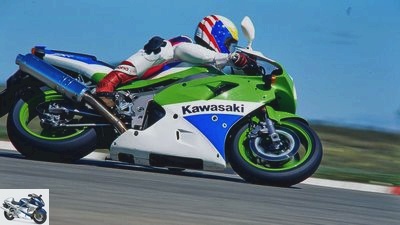
Frank Herzog.
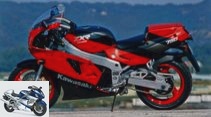
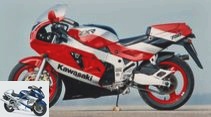
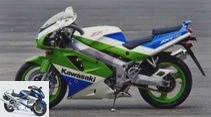
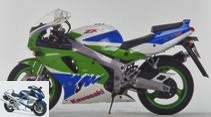
8th photos
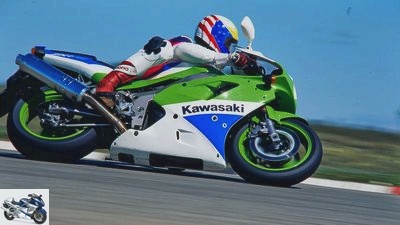
Frank Herzog.
1/8
Despite being heavier than their predecessors, the L and M models offered the best basis for the racetrack.
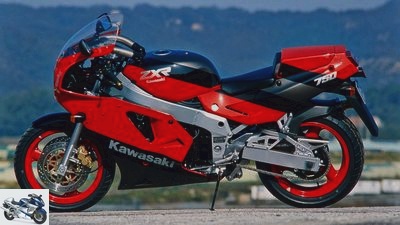
Frank Herzog.
2/8
Kawasaki ZXR 750 H1: 1989 was the launch of the ZXR 750 H1 (15,790 marks).
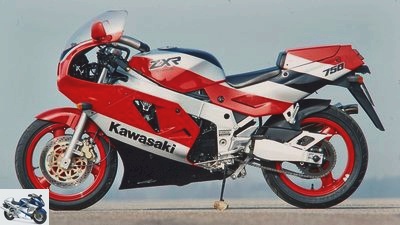
gad, Frank Herzog, Kawasaki, Jens Monnich, racepixx.de
3/8
Kawasaki ZXR 750 H2: In 1990 there were changes to the cylinder head and the carburettor assembly as well as a larger radiator and a stiffer swing arm as an interim solution.
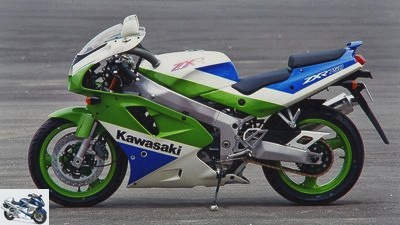
Frank Herzog.
4/8
Kawasaki ZXR 750 J / K: 1991 came the J with 100 HP and constant pressure carburetors, the K with capricious flat slide carburetors.
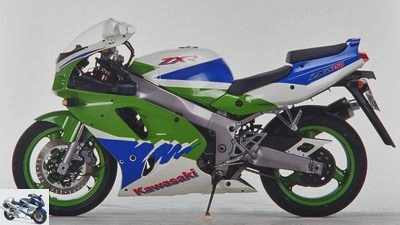
Frank Herzog.
5/8
Kawasaki ZXR 750 L / M: In 1993 there was the first production ZXR with real Ram Air – ironically, without tubes.
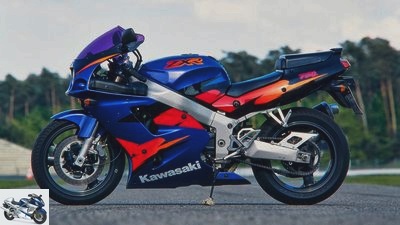
Frank Herzog.
6/8
Kawasaki ZXR 750 L / M: 1996 was the last sales year of the ZXR 750 models (18,990 marks).
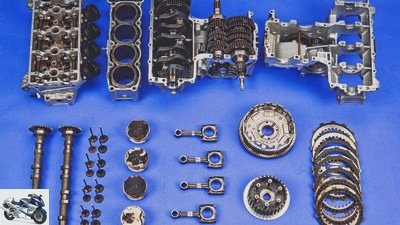
archive.
7/8
Apart from a slightly oval cylinder and a widened seat of the transmission output bearing, the engine of the J appeared almost like new after 50,000 kilometers.
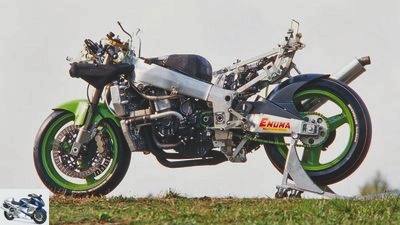
Frank Herzog.
8/8
If you want to build a ZXR 750 at World Championship level, you can orientate yourself here – the 1993 racing machine for the Pro Superbike.
Youngtimer check: Kawasaki ZXR 750
Model type H1 to L / M
Content of
You should provide the racing engines with cool intake air. But the air ducts on the series ZXR 750 from Kawasaki were not functional, were ridiculed and therefore among the most famous "Vacuum cleaner hoses" of motorcycle history.
An engine, especially a racing engine, needs a lot of oxygen under load. Its proportion is higher in cool air than in warm air, which is why one of the difficult tasks of motorcycle designers is to guide the intake air efficiently and with the least possible warming through a heated environment. In today’s motorcycles, the air ducts run through the steering head or around it and are integrated into the sides of the fairing. This solution was still in its shy beginnings at the end of the 1980s, see Yamaha FZR 1000. The designers of KOn the racing motorcycles, awasaki let the urgently needed air flow from the fairing front through hoses into the airbox and also generated more power at high speeds with the help of a slight dynamic pressure.
Extensive changes as early as 1990
The problem with this is that the Superbike World Championship, introduced in 1988, is based on a silhouette rule. Racing motorcycles have to show the same silhouette from all sides as their basic machines from the series. The hoses were also indispensable for the commercially available ZXR 750, although they were not needed for their around 100 hp and were not allowed to flow into the airbox. Very few – including myself – have understood these connections, and so the first reaped "Vacuum cleaner kawa" plenty of ridicule. A later PS and MOTORRAD editor-in-chief even came up with a number of caricaturing photo motifs on the subject of vacuum cleaners and Kawasaki and thus almost involuntarily ended his career as a journalist prematurely. As for the first ZXR 750 H1, Kawasaki was not convinced of its potential either.
archive.
The engine of the Kawasaki ZXR 750 made a good impression in the MOTORRAD endurance test.
As early as 1990 there were extensive changes with the H2, in 1991 a completely redesigned ZXR 750 came onto the market in two versions. With a shorter stroke, valve actuation via rocker arms, a large radiator, snappy brakes and an extremely stiff chassis, this ambitious racetrack motorcycle turned out to be a great success; for me, the real ZXR story begins with him. Unfortunately this ended in silent tragedy. For the successor, the ZX-7R, the footsteps of the ZXR in professional and amateur sports were far too big. After the replacement in 1996, works driver Akira Yanagawa took the then PS sports editor Jurgen Gassebner aside and confessed to him behind closed doors: "Old bike mo ‘, mo‘, mo ‘fast." There is nothing to add.
Model history – H1 to L / M
Kawasaki ZXR 750 H1 (1989)
Frank Herzog.
Kawasaki ZXR 750 H1: 1989 was the launch of the ZXR 750 H1 (15,790 marks).
The market launch of the ZXR 750 H1 was in 1989. Kawa’s hose pioneer showed approaches, but nothing more. The engine, which was derived from the GPX 750, had a central camshaft drive, but only five crankshaft bearings were not speed stable enough for racing, the ducting stood in the way of the necessary increase in performance.
Kawasaki ZXR 750 H2 (1990)
gad, Frank Herzog, Kawasaki, Jens Monnich, racepixx.de
Kawasaki ZXR 750 H2: In 1990 there were changes to the cylinder head and the carburetor equipment as well as a larger radiator and a stiffer swing arm as an interim solution.
Changes to the cylinder head and the carburetor equipment as well as a larger radiator and a stiffer swing arm were only an interim solution. Kawasaki had long been working on a complete and developable new design that came onto the market the following year.
Kawasaki ZXR 750 J / K (1991)
Frank Herzog.
Kawasaki ZXR 750 J / K: 1991 came the J with 100 HP and constant pressure carburetors, the K with capricious flat slide carburetors.
The right-hand camshaft drive enabled a rigid crankshaft with only five main bearings, and valve actuation via rocker arms enabled efficient cam profiles. The J came with 100 HP and constant pressure carburetors, the K with capricious flat slide carburetors.
Kawasaki ZXR 750 L / M ((1993)
Frank Herzog.
Kawasaki ZXR 750 L / M: In 1993 there was the first production ZXR with real Ram Air – ironically, without tubes.
The first series ZXR with real Ram Air – ironically, without tubes. The L with constant pressure carburetors should now produce 122 hp unthrottled, the PS test bench determined at least 113 hp. Nine and seven kilograms more weight clouded the joy of the extra performance a little.
Kawasaki ZXR 750 L / M (1996)
Frank Herzog.
Kawasaki ZXR 750 L / M: 1996 was the last sales year of the ZXR 750 models (18,990 marks).
When the ZX-7R with a bucket tappet motor and an even shorter stroke was already on the market, the ZXR was only sold off. Those who opted for the old one were lucky. Unfortunately, the PS testers were fooled by a particularly well-prepared copy of the ZX-7R.
Market situation for used ZXR
"The ZXR is considered a kamikaze moped and, unfortunately, was often treated that way", a Bavarian Kawasaki dealer emphasizes the difficulty of finding a used ZXR in good condition. Often they are scratched, wildly rebuilt or maltreated on the racetrack. Reasonably useful offers from around 1,500 euros can only be found on the private market, because dealers are reluctant to guarantee old, damaged used machines. The usual mileage ranges between 35,000 and 60,000 kilometers. A well-preserved H or J, which is still very popular despite its age, is available from private customers for 2,000 to 2,500 euros.
Purely series specimens are extremely rare and this is exactly what first collectors are looking for. The RR version (model K and M) is even more in demand in perfect condition and accordingly traded higher. However, one development has boosted the demand for the ZXR: The FIM (International Motorcycle Sports Association) changed the regulations for Classic Endurance Racing and changed the rating for the 750cc class until the 1990s "European Championship" awarded – the ZXR now fits perfectly and hardly any other 750 of this time exudes so much sporting spirit. Incidentally, conversions with the 150 hp engine of the ZX-9R are also occasionally offered
Sports history of the ZXR
Long before the winning streak of Tom Sykes and Jonathan Rea on the ZX-10R, the ZXR 750 formed the basis for Kawasaki’s success in series-based racing. Scott Russell was the only one who managed to break Ducati’s winning streak on his ZXR Model M in 1993. Together with Aaron Slight, who was third in the World Championship, he also won the prestigious Suzuka eight-hour race in the same year. In the previous two years, Rob Phillis had finished third in the World Cup. In the endurance world championship, the ZXR 750 was even good for four titles in a row between 1991 and 1994.
Frank Herzog.
Racing machine for the Pro Superbike from 1993.
The Kawasaki ZXR 750 also played an important role in the German Pro Superbike series, even though Andreas Hofmann missed the greatest chance of a title in 1993. The ambitious Swiss did not want to use the slide rule and suffered two serious falls. In the rain race at the end of the season in Hockenheim, he lost his lead for good by incorrectly directing the pit in the second run. Champion became his Swiss compatriot Edwin Weibel on Ducati. It was left to ex-Grand Prix driver Jochen Schmid to win the 1995 championship for Kawa. At the World Cup race in Hockenheim he also succeeded with the legendary "Paul" a third and a second place.
Jochen Schmid on the Kawasaki ZXR 750
MOTORCYCLE: Jochen, what memories do you have of the ZXR 750
Schmid: I still like to sit on our ZXR 750, which we called Paul, and I immediately feel at home. The engine has really pressure and you can feel exactly what the tires are doing; you can stay in the first corner as if you had already driven 20 laps. I’ve had my greatest successes with this bike, so it’s important to me to ride it at least once a year.
MOTORCYCLE: Well, the Paul is a racing motorcycle built by Kurt Stuckle with the greatest care and diligently further developed by you, but what did the ZXR 750 bring with it in the series version, how good was the base?
Schmid: With the ZXR 750, the frame, swing arm and engine harmonized very well. Its chassis is incredibly stable, reliable when braking into corners and once the ZXR is leaned, it drives really fast when entering the corner. When accelerating out, the rear tire develops enormous traction. The ZXR behaved like a stubborn donkey when changing lean angles quickly, but you were the boss in fast corners. Back then, the engine was already a rocker arm engine and made all around like a racing engine should be. Kurt always praised that too. The technology of the ZXR still fascinates me today.
MOTORCYCLE: How did you get into the Superbike class and the ZXR 750?
Schmid: I competed in the 250cc World Championship until 1993, but I should have brought a large dowry with Yamaha for the 1994 season that I couldn’t afford. The Kawasaki offer came at just the right time to join the Pro Superbike series with Kurt Stuckle as tuner. Before the season started, I went to his workshop in Leutkirch a few times, we had to get to know each other first. At the first pre-season test in Le Castellet, I rode such a powerful racing bike for the first time. That gave me respect. But then I quickly realized that Kurt was right. He gave me the advice to keep clean as with the 250, that would be fine. It was like that.
MOTORCYCLE: In 1995 you really caused a sensation at the first Superbike World Championship run in Hockenheim …
Schmid: Everything just went together. During the 1994 season we were constantly developing, had special camshafts made over the winter, used valves, valve springs and spring plates made of titanium and as one of the few teams used the many gear ratio options offered by the Kawasaki superbike kit.
MOTORCYCLE: A huge effort…
Schmid: You need a team that opens the engine after training, changes gears and puts everything back together properly. Kurt always said: "If you think it will do something, we’ll do it." In the end, we even had different primary translations in very fine gradations. The spring elements were also an important factor. At that time, Kayaba had a sales manager in Dusseldorf named Myamoto, who made a hobby of showing up at the races in Japanese racing mechanics overalls and looking after his drivers. In the winter of 1994/95 he brought us special forks and struts; these were the same parts that Suzuki got for the 500cc GP machines. One sentence is still built into the Paul today. In terms of the processing of the parts and the function, this material is unsurpassed. The shock absorber even has needle-bearing spring pads because the spring rotates when it is compressed. It should address everything very easily, without deadlock.
MOTORCYCLE: How much power does Paul have?
Schmid: I estimate just under 160 hp. Maybe Kurt had the engine on the test bench, but I never saw a performance graph. We didn’t attach great importance to that either. The stopwatch was our test bench.
Related articles
-
Youngtimer test: Kawasaki GPZ 900 R
Youngtimer-Test: Kawasaki GPZ 900 R Then and now strong: Kawasaki GPZ 900 R Kawasaki burst in 1984 with its first four-valve …
-
Youngtimer check: Honda CBR 900 RR Fireblade (SC28 to SC59)
Frank Herzog. 16 pictures Frank Herzog. 1/16 The first: In 1992, the Honda turned the world of super sports on its head. Frank Herzog. 2/16 1000 performance with …
-
Yamaha FZR 1000 in the youngtimer check
Frank Herzog, MOTORRAD Archive, Yamaha 14th photos Frank Herzog, MOTORRAD Archive, Yamaha 1/14 An unthrottled FZR 1000 was considered the speed bike par…
-
Kawasaki ZXR 750 RR in the PS track test
Racepixx.de 21st photos Rene Unger / Racepixx.de 1/21 Uwe Seitz fulfills a 20-year-old wish: with the Kawasaki ZXR 750 RR from Jochen Schmid on the…
-
2014 Kawasaki factory superbike put to the test
KRT 12th photos KRT 1/12 Like all teams, KRT is constantly developing its superbikes (here the Evo-Kawasaki). KRT 2/12 In contrast to Tom Sykes on the…
-
Youngtimer check: Suzuki GSX-R 750 SRAD (GR7DB, type T to type W-X)
Achim Hartmann, Jorg Kunstle, Frank Herzog, MOTORRAD-Archiv 11 pictures Achim Hartmann, Jorg Kunstle, Frank Herzog, MOTORRAD-Archiv 1/11 Suzuki rolled up …
-
Comparison test BMW S 1000 RR, Kawasaki ZX-10R and Yamaha YZF-R1M
22nd photos 1/22 BMW S 1000 RR, Kawasaki Ninja ZX-10R and Yamaha YZF-R1M. 2/22 Yamaha YZF-R1M. 3/22…
-
Zerha 10 photos archive 1/10 1991 Kawasaki Zephyr The alternative to higher-faster-further: the naked bike with air-cooled four-cylinder took up classic…
-
On the move with the Kawasaki Z 1000 R.
wolf 25th photos wolf 1/25 Urahn: The R-engine with roller bearings is still based on the 900 of the Z1. Bore: once 66, now 69.4 mm. wolf 2/25 The series…
-
Gargolov New products: Kawasaki ZX-6R The second in the league In addition to the Honda CBR 600 RR, the Kawasaki ZX-6R is the second super athlete to be…